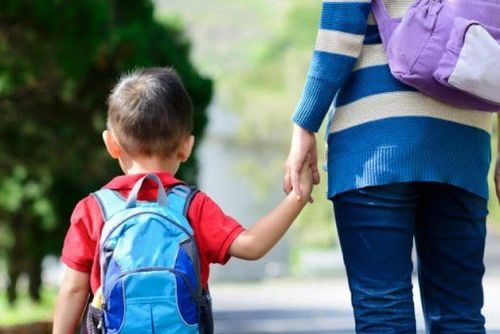This is an automatically translated article.
Before starting school, most children develop an understanding of addition and subtraction through interactions in everyday life. This gives children a head start when they start learning math at school.1. Since when do children use math skills?
Children begin to use math skills in most of their daily activities and routines. But just because kids learn math early doesn't mean they'll take out the calculator and use it during playtime.
Even before children start school, most children have developed an understanding of addition and subtraction through everyday interactions. For example, a child has two toy cars, he gives you one, then he finds that he only has one car left.
Other math skills are introduced through daily routines that you share with your child, such as counting the number of stairs as they go up or down the stairs. Activities like these are also quite effective ways to teach children to learn math. What math knowledge will children need to serve in elementary school later? Early math concepts and skills that first grade math include:
Understanding sizes, shapes, and patterns. Verbal counting ability: first counting ascending, then counting descending. Digit recognition. Determine the number of more and less. Understand one-to-one correspondence: i.e., matching sets or knowing which groups have four and which have five.
2. Key math skills needed for schooling
More advanced math skills build on the original math “foundation,” like a house built on a solid foundation. During the first years of life, you can study math with your baby to help him develop better math skills. Basic math skills children need to know, including: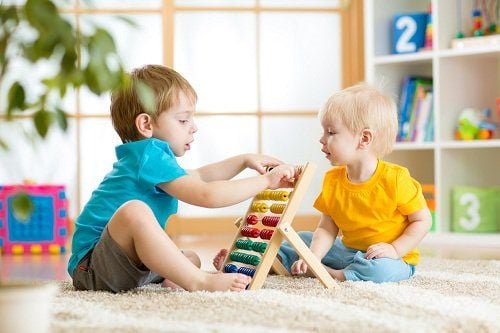
Trẻ bắt đầu sử dụng các kỹ năng toán học trong hầu hết các hoạt động và thói quen hàng ngày của trẻ
2.1. Number Recognition This is the ability to accurately count a sequence of numbers in ascending order. Later in school, children will learn to count down. A more complex skill related to number recognition is the ability to see relationships between numbers like addition and subtraction.
A 2-year-old sees cupcakes on a plate. The child begins to count with the father: “One, two, three, four, five, six...”
2.2. Teaching Children Visually Children are more interested in learning math when math ideas become “real”. You can do this by using words, pictures, symbols and objects related to your child's everyday life.
A 3-year-old is organizing a pretend picnic. The child is carefully laying out four plastic plates and four plastic cups: “So we can go on a picnic together. Our family has four members, you can prepare cups and treat for the whole family.”
2.3. Spatial Sense This knowledge of space is what children will later call "geometry" in school. But for toddlers, they are perceiving everything about shape, size, space, position, direction, and movement.
2.4. Teaching kids how to measure In practice, measuring is finding the length, height, and weight of an object using units like centimeters, meters, or kilograms. Measuring time also falls under this skill area.
2.5. Teach your child about estimation This is the ability to make an accurate guess about the amount or size of something. It is very difficult for young children to do this, you can help them by showing them the meaning of words like bigger, less than, close to, more, less,...
2.6. Problem Solving The ability to think through a problem, to recognize more than one answer. This means using past knowledge and logical thinking skills to find answers.
The child has a cart with 3 holes in the top. Holes are triangular, circular and square. Children pick up a triangular thing, then, they try to insert it into each hole of the car, this time they will be surprised when it falls inside the triangle hole, not the circular hole or square. The child then continues to pick up blocks of different shapes and tries to get them into the car.
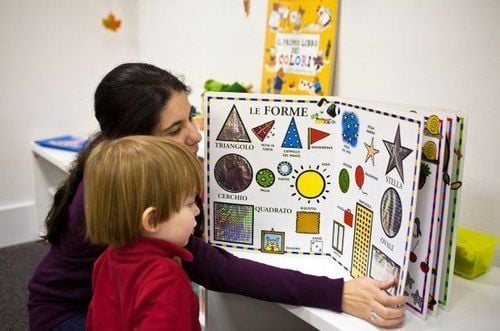
Cha mẹ hãy dạy cho trẻ cách đo đạc và ước lượng bằng những đồ vật xung quanh
3. Math skills part of life
Math skills are just one part of a larger network of skills that children are developing during their early years. These skills include language skills, physical skills, and social skills. This skill will depend on and affect other skills.
An 18-month-old is stacking blocks, she puts two squares on top of each other, and then puts a triangle on top of it. Baby discovers that no more blocks can rest on top of the triangular block. Your child looks up at you and points you to the point where he needs your help. You show him that if he takes out the triangle and replaces it with a square, he can stack more blocks on top to build a taller tower. You can see in this casual interaction how all areas of a child's development are working together. The child's physical abilities allow him to manipulate blocks and use his thinking skills to execute his plan to build a tower. Children use their language and social skills when they ask you for help.
Your child's effective communication gets you to respond and provide the help he or she needs. This helps children further improve their social skills as they see themselves as important people and a good communicator. This work will then help children strengthen their thinking skills as they learn how to solve problems to make the tower taller.
4. Teach kids math through fun everyday activities
Sort objects by shape, color and size, count to ten, recognize groups and patterns. You can help your preschooler master these early math skills simply by playing games in and around the house. If you want your child to enjoy math, show them that math is a part of everyday life and that they'll be more eager to learn when they start school.
Here are 12 fun ways to teach kids math in different ways.
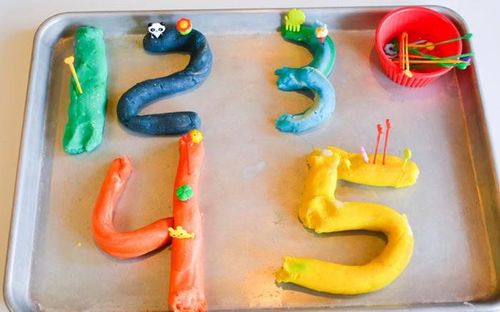
Phân loại các đối tượng theo hình dạng, màu sắc và kích thước, đếm đến mười, nhận biết các nhóm và các mẫu.
4.1. Intuitive way of learning 4.1.1. Look for Numbers
When you're driving around town, ask your child to look for numbers on streets and signs, in shops, as well as on license plates. Call out the numbers as you find them. Children will be able to recognize numbers up to ten before kindergarten.
4.1.2. Connect the dots
Connecting the dots helps children understand numerical sequence, which means a dot is followed by two, two by three, and so on. Bookstores have lots of coloring books with connected themes. Don't worry if your kid just wants a Teletubby or a Pokémon theme, because they all provide numbers for them.
4.1.3. Make a phone call
Write a friend or relative's phone number on a piece of paper. Let the child dial the number so that the child learns to read the number from left to right.
4.1.4. Count everything around your child
You can learn math with your baby by quizzing your child to count everything around them. For example, let children count the number of steps, lights, cars parked on the sidewalk..
4.2. Shape Learning 4.2.1.Count and sort household items
Mix knives, forks and spoons from the silverware drawer and ask the child to group them by type and count how many each group has . Do the same with your sock drawer, asking your child to sort by color, by size. With your child's stuffed animal collection, ask your child to group the animals by size big and small, put all the bears together, then have them help you fold and sort the laundry. How many socks does the child have? How many t-shirts are there? Ask the children to divide them into groups.
4.2.2. Look for shapes around the house
Ask your child to find squares, triangles, circles, stars and any kind of shapes around your house. Children will be asked to recognize, draw and use shapes well when they enter 1st grade. Children's accurate recognition of shapes will help them learn geometry later.
4.2.3. Play with shape and block puzzles
Manipulating three-dimensional objects, such as playing with shape sorting boxes, introduces children to basic geometry and helps them develop fine motor skills and spatial reasoning.
4.2.4. Make a Counting Book
This activity is part reading and part math: With your help, ask your child to go through an old catalog or magazine and cut out all the entries that start with the letter "A" and stick them on a piece of paper. Once you've gone through the list, ask your child to count all the pictures on the paper.
4.2.5. Make a game after snack time
You can give your child a handful of paper goldfish and draw a picture of an aquarium on a piece of white paper. Put the fish in the fish bowl and have the child count, then ask the child to take out one fish and count the number of fish left in the pot.
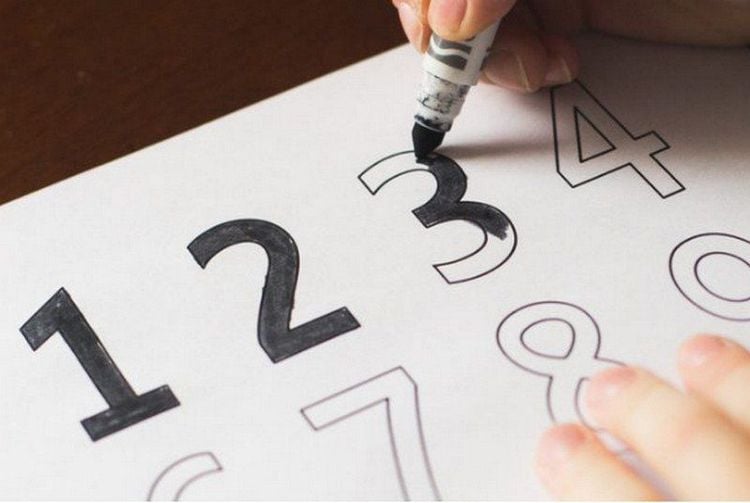
Có rất nhiều cách cha mẹ có thể áp dụng để chơi và học cùng con
4.2.6. Play the model game
When you feed your child green and purple grapes, ask them to arrange them in different orders.
Look for natural patterns in everyday life like: a circle on a caterpillar, a zigzag line on a snail shell, or things that come in pairs like an eye, an ear, or two peanuts in a shell. This activity will help develop children's problem-solving skills and abstract thinking ability.
4.3. Sound-related learning 4.3.1. Listen to count by song
You can learn to count with your child through common songs appropriate to the child's age. Any variation of this counting rhyme introduces basic subtraction to children. Look for games for kids and songs about numbers.
4.3.2. Make a recipe together with your child
Give them measuring cups and bowls and let them measure ingredients while you read the instructions aloud. An easy way to learn math with your baby to introduce concepts like mass and weight to your child.
Whether teaching children to learn math or learning to count, parents must not forget to pay attention to their children's health and nutrition during the growing period. This will affect future development.
In addition, during this period, children often suffer from digestive diseases, fever, teething, and respiratory problems. Pediatrics - Vinmec International General Hospital is always the place to receive and intensively treat common problems in children. With a team of doctors with experience, good expertise and understanding of child psychology, they will help parents solve the problems their children are facing in the best and most effective way.
Please dial HOTLINE for more information or register for an appointment HERE. Download MyVinmec app to make appointments faster and to manage your bookings easily.
Source: babycenter.com - zerotothree.org




